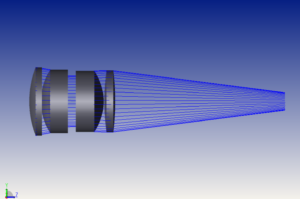Designed for scientific and R&D applications, short-wave infrared (SWIR) cameras are often based on an InGaAs detector, generally with VGA resolution (640 x 512) optimized for the 0.9-1.7 µm waveband.
Infrared is itself divided into several sub-domains:Near Infrared(NIR),Short Wavelength Infrared(SWIR), MediumWavelength Infrared (MWIR),Long Wavelength Infrared (LWIR) and Very LongWavelength Infrared (VLWIR).

The table below summarizes some of the physical characteristics of the different domains that make up the infrared spectrum.
| Domain | λ (μm) | ν (THz) | E (eV) | Wave number (cm-1) |
|---|---|---|---|---|
| NIR | 0.750 - 0.9 | 400 - 330 | 1.65 - 1.38 | 13333 - 11111 |
| SWIR | 0.9 à 3 | 330 - 100 | 1.38 - 0.41 | 11111 - 3333 |
| MWIR | 3 - 5 | 100 - 60 | 0.41 - 0.25 | 3333 - 2000 |
| LWIR | 5 - 15 | 60 - 30 | 0.25 - 0.083 | 2000 - 666 |
| VLWIR | 15 - 1000 | 20 - 0.3 | 0.083 - 0.001 | 666 - 100 |
SWIR InGaAs detectors
InGaAs, or indium gallium arsenide, is an alloy of gallium arsenide and indium arsenide. It belongs to the InGaAsP quaternary system, made up as follows:
- indium arsenide alloys (InAs)
- gallium arsenide (GaAs)
- indium phosphide (InP)
- gallium phosphide (GaP)
These binary materials and their alloys are all III-V compound semiconductors. According to the periodic table, gallium and indium belong to group III, and arsenic and phosphorus to group V.
As you probably know, the electrical and optical properties of a semiconductor depend on its energy band gap. A semiconductor will only detect light whose photon energy is greater than the band gap. In terms of wavelength, it will detect light whose wavelength is less than the cut-off wavelength. Standard InGaAs, for example, has a cut-off wavelength of 1.68 µm.
SWIR applications
SWIR imagers were first developed in the 1960s. They were first marketed in 1985 [1]. Despite their early development, the market for SWIR imagers today is rather low-key compared with MWIR and LWIR imagers and, above all, visible imagers. There are many applications for SWIR, but the detector technology itself is expensive. A SWIR camera costs around €20,000. As a result, they are mainly used in three fields: security, scientific research and industrial control.
If we go into a little more detail about its areas of application, we can summarize them as follows:
- military and security
- industrial
- medical
- air and space
- scientists
Here are just a few examples of applications:
- thermography (high-temperature measurements)
- agriculture (hyperspectral measurements)
- food processing (spectroscopy)
- monitoring
- astronomy
- communication (FSO, Free Space Optical)
The main benefits of SWIR
Concerning fog
We often hear that SWIR imaging can see through fog. This is partly true, provided we define fog correctly! Without going into too much technical detail, light is more scattered when the wavelength is short and when the scattering particles are small. This means that SWIR radiation will be less scattered than visible light in the case of smoke and light fog. On the other hand, in the case of thick fog, SWIR will not pass through it.
Image quality
In SWIR, as in the visible, photons are reflected and/or absorbed by an object. This physical property enables SWIR to provide the high contrast required for high-resolution imaging. This provides additional information about a scene or object. In fact, SWIR images are often very pleasing to the human eye.
For eye safety
SWIR is often used in active imaging, thanks to the ocular safety of the associated laser wavelength. To find out more about these systems, visit theInstitut Saint-Louis website, experts in active imaging.
The main SWIR players
The table below lists the main international SWIR players (cameras and/or detectors):
| Company | Nationality |
|---|---|
| Lynred (formerly Sofradir) | France |
| NIT | France |
| First Light Imaging | France |
| Allied Vision | Germany |
| EHD Imaging | Germany |
| Selex | UK |
| Raptor Photonics | UK |
| Photonics Science | UK |
| SWIR Vision Systems | UK |
| Xenics | Belgium |
| Photon Focus | Switzerland |
| SCD | Israel |
| Trieye | Israel |
| Raytheon | USA |
| DRS | USA |
| Flir | USA |
| Intevac | USA |
| Quantum Imaging | USA |
| Princeton Infrared | USA |
| Teledyne e2v | USA |
| UTC | USA |
| Atollo Engineering | USA |
| Photon etc | Canada |
| Chunghwa | Taiwan |
| Hamamatsu | Japan |
| Sony | Japan |
| Ghopto | China |
| Mikro-Tasarim | Turkey |
Conclusion
As we have seen in this article, SWIR offers a number of advantages over visible light. Firstly, the wavelength of the associated laser provides ocular security for active imaging applications. Secondly, the contrast provided by SWIR is often greater than that of visible light. Finally, unlike visible light, SWIR can penetrate smoke and light fog.
If you'd like to discuss your SWIR application, please contact us via our contact page and we'll get back to you as soon as possible.
You can also visit our "solutions" page to find out more about our optronics activities.



